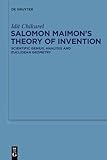Salomon Maimon’s Theory of Invention : Scientific Genius, Analysis and Euclidean Geometry / Idit Chikurel.
Material type: TextPublisher: Berlin ; Boston : De Gruyter, [2020]Copyright date: ©2020Description: 1 online resource (X, 168 p.)Content type:
TextPublisher: Berlin ; Boston : De Gruyter, [2020]Copyright date: ©2020Description: 1 online resource (X, 168 p.)Content type: - 9783110691337
- 9783110691412
- 9783110691351
- 100
- online - DeGruyter
- Issued also in print.
| Item type | Current library | Call number | URL | Status | Notes | Barcode | |
|---|---|---|---|---|---|---|---|
 eBook
eBook
|
Biblioteca "Angelicum" Pont. Univ. S.Tommaso d'Aquino Nuvola online | online - DeGruyter (Browse shelf(Opens below)) | Online access | Not for loan (Accesso limitato) | Accesso per gli utenti autorizzati / Access for authorized users | (dgr)9783110691351 |
Frontmatter -- Acknowledgements -- Contents -- Abbreviations -- Introduction -- Chapter 1: The Genius and the Methodical Inventor -- Chapter 2: An Art of Finding Arguments -- Chapter 3: Invention, Analysis and Synthesis -- Chapter 4: Methods of Invention -- Conclusion -- Bibliography -- Index of Terms -- Index of Person
restricted access online access with authorization star
http://purl.org/coar/access_right/c_16ec
How can we invent new certain knowledge in a methodical manner? This question stands at the heart of Salomon Maimon's theory of invention. Chikurel argues that Maimon's contribution to the ars inveniendi tradition lies in the methods of invention which he prescribes for mathematics. Influenced by Proclus' commentary on Elements, these methods are applied on examples taken from Euclid's Elements and Data. Centering around methodical invention and scientific genius, Maimon's philosophy is unique in an era glorifying the artistic genius, known as Geniezeit. Invention, primarily defined as constructing syllogisms, has implications on the notion of being given in intuition as well as in symbolic cognition. Chikurel introduces Maimon's notion of analysis in the broader sense, grounded not only on the principle of contradiction but on intuition as well. In philosophy, ampliative analysis is based on Maimon's logical term of analysis of the object, a term that has yet to be discussed in Maimonian scholarship. Following its introduction, a new version of the question quid juris? arises. In mathematics, Chikurel demonstrates how this conception of analysis originates from practices of Greek geometrical analysis.
Issued also in print.
Mode of access: Internet via World Wide Web.
In English.
Description based on online resource; title from PDF title page (publisher's Web site, viewed 27. Jan 2023)


